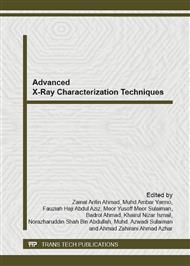p.330
p.335
p.340
p.345
p.350
p.356
p.362
p.368
p.373
Synthesis and Gas Sensing Properties of SnO2 Nanostructures by Thermal Evaporation
Abstract:
Tin oxide nanostructures (NS) were grown on silicon substrates by thermal evaporation method with three different parameters. These parameters were temperatures (650 °C, 750 °C and 850 °C), nickel catalyst concentrations (0, 5 and 10 milimoles) and tin powder source to substrate distances (2 cm, 4 cm and 6 cm). The parameters were found to affect the size and morphology of the synthesized nanostructures. Formation of nanospheres (NSs), nanoneedles (NNs) and nanowires (NWs) of tin oxide were observed by Scanning Electron Microscope (SEM) at different synthesis conditions. Synthesis temperature was found to have most pronounced effect on the size and morphology of the nanostructures. Catalyst concentration has affected the porosity and growth of the nanostructures. The distance between source and substrate affected the nanostructures predominately on distribution and particle size. Energy dispersion X-ray (EDX) analysis confirms the presence of tin and oxygen in all nanostructures at all synthesis conditions. X-ray diffraction (XRD) proves the formation of tin oxide phase in all samples. Significant formation of tin oxide nanowires was observed at 850 °C. Gas sensing properties of SnO2 nanowires (NW) toward ethanol (C2H5OH) gas at 450°C with different volume concentration was measured. It was found SnO2 NW had good sensing properties for C2H5OH at 100 ppm compared to measurements made at 25-50 ppm.
Info:
Periodical:
Pages:
350-355
Citation:
Online since:
December 2012
Keywords:
Price:
Сopyright:
© 2013 Trans Tech Publications Ltd. All Rights Reserved
Share:
Citation:


